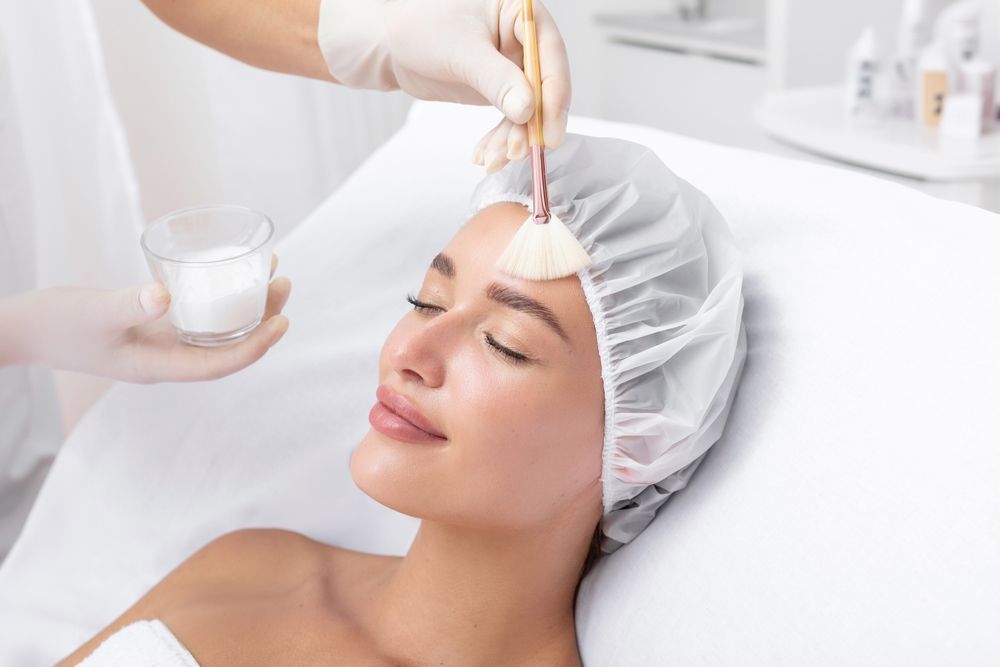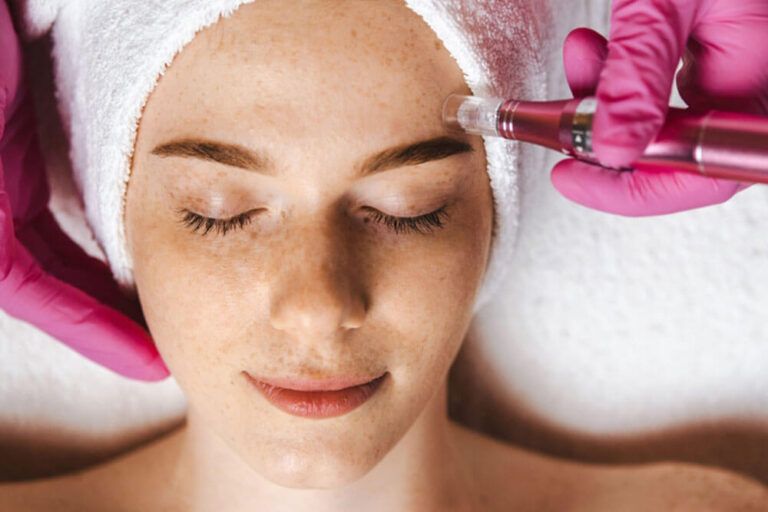In the pursuit of radiant, smooth skin, many turn to the transformative power of chemical peels. This popular and highly effective skincare treatment has become a cornerstone in the beauty industry, known for its ability to address a wide range of skin concerns. From improving texture and tone to reducing the appearance of fine lines and acne scars, chemical peels offer a versatile solution for achieving a brighter, more youthful complexion. In this blog, we’ll explore the different types of chemical peels, their myriad benefits, and how they can help you achieve your skincare goals, leaving you with a rejuvenated and glowing appearance.
In This Blog:
- What are Chemical Peels?
- Benefits of Chemical Peels
- The Chemical Peel Process
- Choosing the Right Chemical Peel for Your Skin Type
What Are Chemical Peels?
Chemical peels are skin-resurfacing treatments that use a chemical solution to exfoliate and remove the top layers of skin. This process reveals the smoother, more radiant skin underneath, making it a popular choice for those seeking to improve their skin’s texture and appearance. There are three main types of chemical peels, each varying in strength and depth of penetration: superficial, medium, and deep peels.
Superficial Peels:
Also known as “lunchtime peels,” these are the mildest type and use alpha hydroxy acids (AHAs) or beta hydroxy acids (BHAs). They gently exfoliate the outer layer of skin, making them suitable for all skin types and ideal for addressing minor skin imperfections and maintaining a youthful glow.
Medium Peels:
These peels penetrate deeper into the skin and often use trichloroacetic acid (TCA). They are effective for treating fine lines, wrinkles, acne scars, and uneven skin tone. Medium peels typically require some downtime as the skin heals and regenerates.
Deep Peels:
Using stronger acids like phenol, deep peels provide the most dramatic results by deeply penetrating the skin layers. They are used for more severe skin issues such as deep wrinkles, extensive sun damage, and pronounced scars. Due to their intensity, deep peels involve a longer recovery period and are performed less frequently.
Chemical peels work by causing the outer layer of the skin to slough off, stimulating the production of new skin cells and collagen. This results in a fresh, rejuvenated complexion with improved texture and reduced imperfections. Whether you’re looking to address specific skin concerns or simply want to maintain a youthful, glowing appearance, chemical peels offer a customizable solution to meet your skincare needs.
Benefits of Chemical Peels
Chemical peels offer a multitude of benefits, making them a sought-after treatment for those looking to enhance their skin’s appearance and health. Here are some of the key advantages of chemical peels:
Exfoliation and Removal of Dead Skin Cells:
Chemical peels effectively exfoliate the skin by removing the outermost layer of dead skin cells. This process reveals the fresh, new skin beneath, resulting in a smoother and more radiant complexion.
Improvement of Skin Texture and Tone:
By promoting the turnover of skin cells, chemical peels help to even out skin texture and tone. This can lead to a more uniform and polished appearance, reducing the visibility of rough patches and uneven pigmentation.
Reduction of Fine Lines and Wrinkles:
Chemical peels stimulate collagen production, which is essential for maintaining the skin’s elasticity and firmness. Over time, this can help to diminish the appearance of fine lines and wrinkles, giving the skin a more youthful look.
Treatment of Acne and Acne Scars:
Chemical peels, particularly those containing salicylic acid (a type of BHA), are effective in treating acne by unclogging pores and reducing inflammation. They can also help to minimize the appearance of acne scars by promoting skin regeneration and smoothing out uneven skin texture.
Lightening of Hyperpigmentation and Age Spots:
Chemical peels can target areas of hyperpigmentation, such as sun spots, melasma, and age spots. By accelerating cell turnover, peels help to fade dark spots and create a more even skin tone.
Stimulation of Collagen Production for Firmer Skin:
The exfoliation and cell renewal triggered by chemical peels encourage the skin to produce more collagen. This vital protein helps to keep the skin firm, plump, and youthful, reducing the signs of aging and improving overall skin resilience.
Overall, chemical peels offer a versatile and effective solution for a range of skin concerns, from minor imperfections to more pronounced signs of aging. By regularly incorporating chemical peels into your skincare routine, you can achieve and maintain a brighter, smoother, and more youthful complexion.
The Chemical Peel Process
Undergoing a chemical peel is a multi-step process that begins with a thorough consultation and ends with post-treatment care to ensure optimal results. Here’s a detailed look at what you can expect during the chemical peel process:
Pre-Treatment Consultation and Skin Assessment
- Professional Evaluation: Before undergoing a chemical peel, a skincare professional will evaluate your skin type, concerns, and medical history to determine the most suitable peel for you.
- Customization: The type of peel, strength of the solution, and number of treatments will be customized based on your individual needs and goals.
Steps Involved in a Chemical Peel Treatment
- Preparation of the Skin: Your skin will be thoroughly cleansed to remove any makeup, oils, and impurities. In some cases, a pre-peel solution might be applied to prepare the skin and enhance the peel’s effectiveness.
- Application of the Chemical Solution: The chosen chemical solution is applied to the skin using a brush, cotton pad, or sponge. You may feel a mild tingling or stinging sensation as the solution works to exfoliate the skin.
- Neutralization and Removal of the Peel: After a specified period, the chemical solution is either neutralized or removed, depending on the type of peel used. For some peels, a neutralizing agent is applied to stop the action of the acid, while others may be simply washed off with water.
Post-Treatment Care and Recovery
- Immediate Aftercare: Expect some redness and a sunburn-like sensation immediately after the peel, which can last for several hours to a few days. Your skincare professional may apply a soothing ointment or moisturizer to help calm the skin.
- Healing and Peeling: Over the next few days, the outer layer of your skin will begin to peel away, revealing fresh, new skin underneath. It’s crucial not to pick or peel the skin manually to avoid scarring or infection.
- Importance of Sun Protection: The new skin will be more sensitive to the sun, so wearing broad-spectrum sunscreen with at least SPF 30 is essential. Avoid direct sun exposure as much as possible during the healing process.
Recommended Skincare Routine:
- Follow a gentle skincare routine as advised by your skincare professional, including the use of mild cleansers, moisturizers, and any recommended post-peel products.
- Avoid using harsh exfoliants, retinoids, or any other irritating products until your skin has fully healed.
By following these steps and adhering to the post-treatment care instructions, you can maximize the benefits of your chemical peel and enjoy brighter, smoother skin. Regular follow-up treatments can help maintain and enhance your results over time.
Choosing the Right Chemical Peel for Your Skin Type
Selecting the appropriate chemical peel for your skin type and concerns is crucial for achieving the best results and minimizing potential risks. Here’s a guide to help you understand how to choose the right chemical peel:
Importance of Professional Evaluation
- Consult a Skincare Professional: Always seek the advice of a certified skincare professional or dermatologist who can assess your skin and recommend the most suitable type of peel.
- Personalized Treatment Plan: A professional will take into account your skin type, specific concerns, and desired outcomes to tailor a treatment plan that meets your needs.
Tailoring the Peel to Individual Skin Concerns and Goals
- For Sensitive Skin: Superficial peels with mild acids like lactic acid or glycolic acid are generally recommended for sensitive skin to avoid irritation and inflammation.
- For Oily and Acne-Prone Skin: Beta hydroxy acid (BHA) peels, such as those containing salicylic acid, are effective in controlling oil production and treating acne.
- For Dry Skin: Alpha hydroxy acid (AHA) peels, such as those with lactic acid, can help exfoliate and hydrate dry skin, improving texture and moisture levels.
- For Aging Skin: Medium to deep peels using trichloroacetic acid (TCA) or phenol can reduce the appearance of fine lines, wrinkles, and age spots by promoting collagen production and skin regeneration.
Discussing Potential Risks and Side Effects
- Transparency About Risks: Your skincare professional should discuss any potential risks and side effects based on your chosen peel and skin type.
- Managing Expectations: Understanding the recovery process and what to expect post-treatment will help you manage expectations and ensure a smooth healing process.
Examples of Chemical Peels Suitable for Different Skin Types
- Superficial Peels: Ideal for all skin types, especially those new to chemical peels or with mild skin concerns.
- Medium Peels: Suitable for individuals with moderate skin imperfections and those seeking more noticeable results.
- Deep Peels: Best for individuals with severe skin concerns and those willing to undergo a longer recovery period for dramatic improvements.
Conclusion
Chemical peels are a powerful and versatile treatment option for achieving brighter, smoother skin. By effectively exfoliating and rejuvenating the skin, chemical peels can address a wide range of concerns, from fine lines and wrinkles to acne scars and hyperpigmentation. The key to maximizing the benefits of chemical peels lies in choosing the right type of peel for your skin and working with a professional to create a customized treatment plan. With proper care and maintenance, chemical peels can help you achieve a radiant, youthful complexion that boosts your confidence and enhances your overall appearance. For those looking to embark on their journey to better skin, consulting with a skincare professional is the first step toward unlocking the transformative power of chemical peels.
Yuliya Crosley, ARNP is a registered nurse with 28 years of experience in the medical field and 5 plus years in medical aesthetics. She has been internationally trained by some of the most advanced aesthetic providers and plastic surgeons in the country and abroad, is certified in advanced aesthetic procedures and facial rejuvenation, and attends multiple workshops, seminars, symposiums, and trainings. She is an expert in dermal fillers, facial profile balancing, lips augmentation, advanced aesthetic laser skin resurfacing, body contouring, PDO thread lift, and medical grade skin care.














